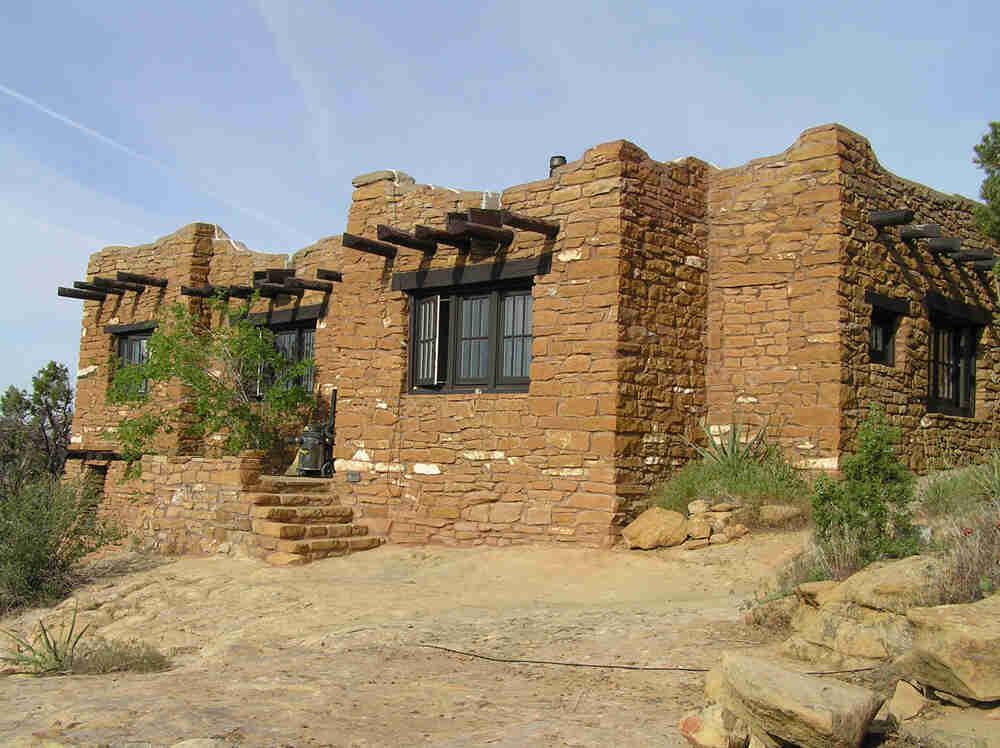Mesa Verde National Park Administrative District
Full Article
The Mesa Verde National Park Administrative District consists of six Pueblo Revival structures originally built by park superintendent Jesse Nusbaum along the rim of Spruce Tree Canyon in the 1920s. The buildings were the first in the National Park Service to highlight a park’s cultural theme, and the Pueblo Revival style Nusbaum used later became standard for structures in national parks and national monuments across the Southwest. In 1987 the administrative district was listed as a National Historic Landmark.
Early Years
When Mesa Verde became a national park in 1906, it was located in a remote, hard-to-reach corner of Colorado. It was also the first national park dedicated to preserving cultural heritage rather than natural beauty. As a result, visitation numbers were relatively low and the development of park facilities proceeded slowly. Initially the park superintendent lived in Mancos, miles from the park entrance, and no accommodations were available to travelers within the park itself.
By 1908 the park designated a camping area for visitors. Early rangers stayed in a small tar-paper shack at Spruce Tree Camp, located on the rim of Spruce Tree Canyon above Spruce Tree House. Starting in 1911, a ranger’s wife operated a park concession at the camp, offering visitors meals, tents, and bedding.
In the 1910s, Spruce Tree Camp was developed into a center of activity in the park. In 1916 the tar-paper ranger shack was upgraded to a log cabin, and in 1917 the cabin was converted to a museum, the first to open in a national park, with cases of artifacts installed in 1918. By that year the area also had a building with dining and service rooms (often referred to as a hotel), three rows of twenty-nine tents, electric lighting, water, automobile sheds, and a four-room ranger station.
Jesse Nusbaum’s Construction Program
Despite the developments at Spruce Tree Camp, Mesa Verde National Park was not well run in the 1910s. The park superintendent still lived in Mancos, rangers never spent winters in the park, and the facilities at Spruce Tree Camp were all temporary structures haphazardly cobbled together. Nepotism and pot hunting were prevalent. To improve the park’s situation, in 1921 the National Park Service chose Jesse Nusbaum as the park’s new superintendent, marking the first time a trained archaeologist was put in charge of Mesa Verde.
One of Nusbaum’s earliest and most important decisions was to move park headquarters from Mancos to Spruce Tree Camp and develop an administrative center there. The first building he and his wife, Aileen, constructed was the superintendent’s residence, located on a rocky ledge overlooking Spruce Tree House. They based the design on the architecture of Hopi Indians, descendants of the Ancestral Puebloan peoples who built the structures preserved at Mesa Verde, because that would make the residence suited to the park’s environment and atmosphere, enable the use of local materials, and encourage visitor interest in the park’s ancient structures. They completed the four-room stone house in time to spend the winter of 1921–22 in the park, where they made furniture modeled on early Spanish colonial styles for their home.
The superintendent’s residence, which proved incredibly popular with park visitors, marked a turning point in National Park Service architecture. It was the first National Park Service building with a design based on local cultural traditions, and its success paved the way for the use of Pueblo Revival architecture for new buildings at Mesa Verde in the 1920s and at national parks and monuments across the entire Southwest in the 1930s. More generally, Nusbaum’s design for the superintendent’s residence and other buildings at Mesa Verde influenced the National Park Service’s preference for architecture based on local cultural traditions at parks designed to preserve cultural resources.
Jesse and Aileen Nusbaum soon drew up a full plan for the development of park facilities at Spruce Tree Camp, which was implemented over the next decade. All the buildings were designed in the same Pueblo Revival style as the superintendent’s residence, with sandstone walls, flat roofs, vigas, and corner fireplaces. They also featured similar Spanish colonial furniture, most of which was made by park employees during the off season. In 1923 park staff built a three-room park headquarters just north of the superintendent’s residence as well as a small restroom building (now a post office) to the west. In 1925 they added new ranger housing, and in 1927 they built a community house, which later became a natural history museum and then the chief ranger’s office.
Meanwhile, Nusbaum started a campaign for a better park museum, soliciting donations from wealthy visitors such as John D. Rockefeller Jr. A new museum building was erected in 1923–24 and expanded significantly in 1936 to make it by far the largest building at Spruce Tree Camp. Called the Chapin Mesa Archaeological Museum, it included six exhibit halls and a large auditorium designed to resemble the interior of early Spanish colonial churches.
Today
Even after Jesse Nusbaum stepped down as park superintendent in 1931, he continued to serve as an archaeological consultant for the National Park Service and to review all proposed alterations to his buildings at Mesa Verde. Most of the buildings at Spruce Tree Camp have been expanded multiple times and have seen minor modernizations, but they still retain the same basic character as when they were built in the 1920s.


